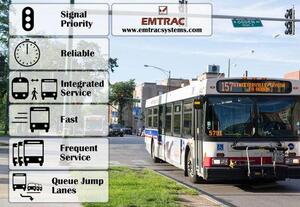-
 Find in Members
Find in Members Find in Videos
Find in Videos Find in Channels
Find in Channels
This website uses cookies to ensure you get the best experience on our website.
To learn more about our privacy policy Click herePrivacy Preference
- Tags - #bus signal priority
-
- Last updated November 28, 2022 0 comments, 135 views, 0 likes
- 1201 W Randolph St, Chicago, IL, USA - Get Directions
More from emtrac systems
More in Politics
Related Blogs
The Major Benefits of Bus signal priority and its types
Body
Public transport is preferred in cities due to reduced pollution and fewer emissions. Such vehicles are more fuel efficient many passengers can be accommodated in the vehicle avoiding traffic congestion. It is crucial as we see more mobility for people who aren't able to move or travel much. It helps free up time for the passengers, who can spend their travel time on other things. It is often one of the safest alternatives for traveling.
There is an increased preference now given to Bus Signal Priority that ensures the bus reaches on time and creates a fast, safe and reliable journey for all the passengers.
Understanding Bus Priority System –
Bus priority systems make way for buses at crossroads or junctions with controlled traffic signals by giving buses extended green lights or reducing the red-light time limit with the system.
Bus priority can be both passive or active and can be summarized as follows:
- Passive bus priority mainly revolves around optimizing signal timing or coordinating successive signals to create a "Green Wave" for the bus. Passive bus priority requires no specialized hardware and focuses on improving the general traffic along the bus route.
- Active bus priority relies on connected driving with different solutions that allow buses, traffic signals, and systems to communicate and coordinate.
Earlier versions of priority solutions were often expensive and bulky and gave the little possibility to follow up if the priority worked reliably. With Bus signal priority, the user can give access to a steady stream of reliable statistics and data, allowing you to follow up and configure the prioritization to ensure it operates efficiently.
Benefits of bus and signal priority:
- Reduced travel times for buses
- It is observed that the use of signal priority for buses lowers the average time going through an intersection from 60 seconds to 41 seconds, which explains that the estimated travel time will reduce by a full minute for every three intersections the bus passes through.
- Improved bus schedule adherence and transit efficiency
- By implementing more green lights, the bus will be better able to adhere to its schedule and be more on time.
- A more attractive option
- Bus priority is a cost-effective method to enhance public transportation mobility, making it a more attractive option than cars.
Get in Touch:
location: Manufactured By STC, Inc. 1201 W. Randolph St, McLeansboro, IL 62859
phone: Richard D’Alessandro: (214) 607–0100
Fax: (214) 607–0105
Email: info@emtracsystems.com
Web: www.emtracsystems.com/
Photos
Map
-
Locations on MyWorldGo
Location Information
- Location: 1201 W Randolph St, Chicago, IL, USA - Get Directions
- Formatted Address: 1201 W Randolph St, Chicago, IL 60607, USA
- Street Address: 1201,West Randolph Street,West Loop,Chicago
- City: Cook County
- Zipcode: 60607
- State: Illinois
- Country: United States








Comments